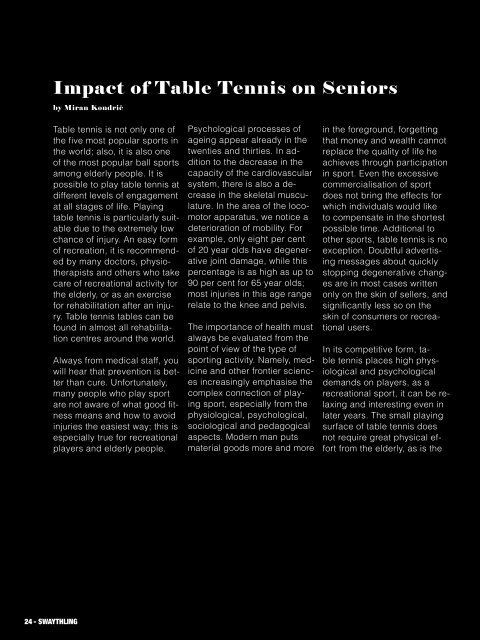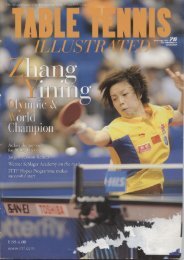Swaythling_Mag_112-1 (2023_04_26)
You also want an ePaper? Increase the reach of your titles
YUMPU automatically turns print PDFs into web optimized ePapers that Google loves.
Impact of Table Tennis on Seniors<br />
by Miran Kondrič<br />
Table tennis is not only one of<br />
the five most popular sports in<br />
the world; also, it is also one<br />
of the most popular ball sports<br />
among elderly people. It is<br />
possible to play table tennis at<br />
different levels of engagement<br />
at all stages of life. Playing<br />
table tennis is particularly suitable<br />
due to the extremely low<br />
chance of injury. An easy form<br />
of recreation, it is recommended<br />
by many doctors, physiotherapists<br />
and others who take<br />
care of recreational activity for<br />
the elderly, or as an exercise<br />
for rehabilitation after an injury.<br />
Table tennis tables can be<br />
found in almost all rehabilitation<br />
centres around the world.<br />
Always from medical staff, you<br />
will hear that prevention is better<br />
than cure. Unfortunately,<br />
many people who play sport<br />
are not aware of what good fitness<br />
means and how to avoid<br />
injuries the easiest way; this is<br />
especially true for recreational<br />
players and elderly people.<br />
Psychological processes of<br />
ageing appear already in the<br />
twenties and thirties. In addition<br />
to the decrease in the<br />
capacity of the cardiovascular<br />
system, there is also a decrease<br />
in the skeletal musculature.<br />
In the area of the locomotor<br />
apparatus, we notice a<br />
deterioration of mobility. For<br />
example, only eight per cent<br />
of 20 year olds have degenerative<br />
joint damage, while this<br />
percentage is as high as up to<br />
90 per cent for 65 year olds;<br />
most injuries in this age range<br />
relate to the knee and pelvis.<br />
The importance of health must<br />
always be evaluated from the<br />
point of view of the type of<br />
sporting activity. Namely, medicine<br />
and other frontier sciences<br />
increasingly emphasise the<br />
complex connection of playing<br />
sport, especially from the<br />
physiological, psychological,<br />
sociological and pedagogical<br />
aspects. Modern man puts<br />
material goods more and more<br />
in the foreground, forgetting<br />
that money and wealth cannot<br />
replace the quality of life he<br />
achieves through participation<br />
in sport. Even the excessive<br />
commercialisation of sport<br />
does not bring the effects for<br />
which individuals would like<br />
to compensate in the shortest<br />
possible time. Additional to<br />
other sports, table tennis is no<br />
exception. Doubtful advertising<br />
messages about quickly<br />
stopping degenerative changes<br />
are in most cases written<br />
only on the skin of sellers, and<br />
significantly less so on the<br />
skin of consumers or recreational<br />
users.<br />
In its competitive form, table<br />
tennis places high physiological<br />
and psychological<br />
demands on players, as a<br />
recreational sport, it can be relaxing<br />
and interesting even in<br />
later years. The small playing<br />
surface of table tennis does<br />
not require great physical effort<br />
from the elderly, as is the<br />
case, for example, with other<br />
sports games with rackets.<br />
However, even in activities that<br />
harm the locomotor apparatus<br />
(competitive or elite level), table<br />
tennis does not have a degenerative<br />
effect on the joints<br />
and spine. Practically nowhere<br />
in the medical reports do we<br />
find that doctors forbid playing<br />
table tennis on a recreational<br />
level. Even more, table tennis<br />
tables can be found in most<br />
rehabilitation centres worldwide;<br />
with a slightly larger ball<br />
(40 mm), the International Table<br />
Tennis Federation has also<br />
ensured better control of the<br />
table tennis game at all levels<br />
of play. A slower ball allows a<br />
greater number of strokes to<br />
be exchanged as well as better<br />
control. In some countries,<br />
you can find also practise with<br />
“big ball”; in Japan there are<br />
44mm ball tournaments.<br />
24 - SWAYTHLING SWAYTHLING - 25

















